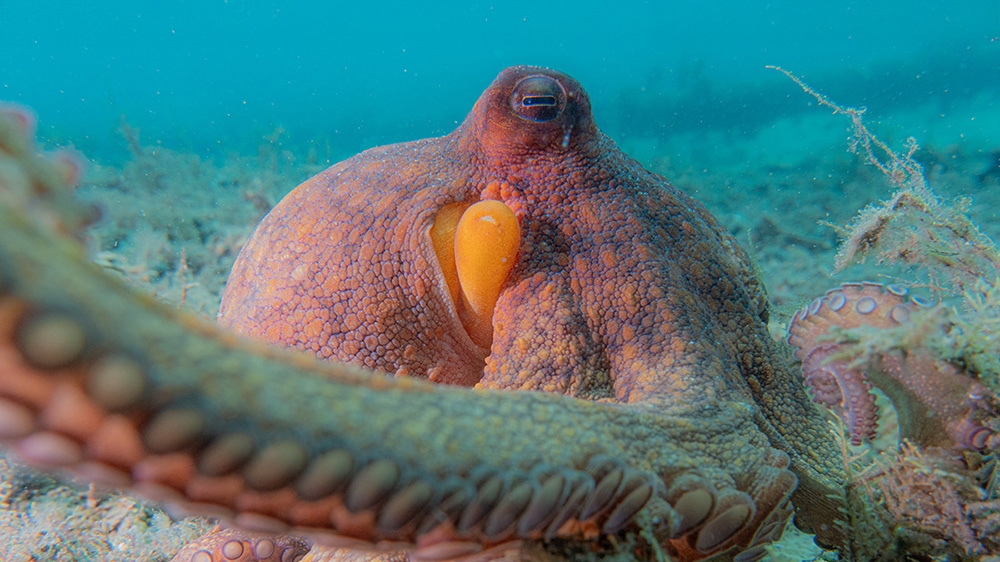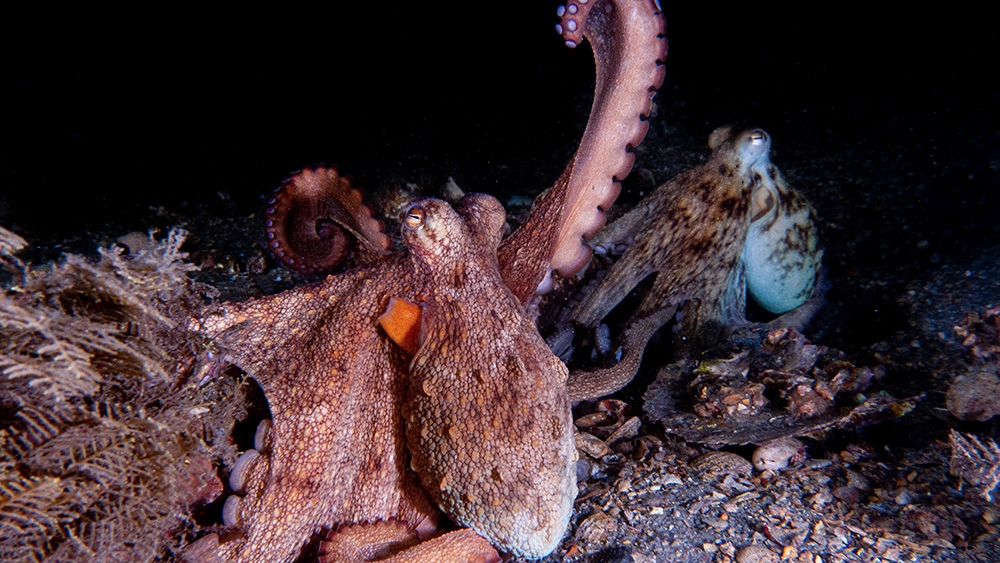How Many Ways Can an Octopus Flex its Supple Arms? Now We Know.

WOODS HOLE, Mass. -- Octopus arms are one of the most flexible structures known in all of the biological world. Their agility is so extraordinary that robotics researchers want to learn the secrets behind their movements, hoping to apply some of the same principles. They envision soft, flexible robotic appendages that, like the highly tactile octopus arms, can search and carry out tasks through tight and narrow openings, such as delivering life-saving food and water to people trapped in the rubble of collapsed buildings.
Now, researchers from the Marine Biological Laboratory (MBL) in Woods Hole and Florida Atlantic University (FAU) have published the most detailed study ever of the complex motions of octopus arms. They videorecorded 25 octopuses in their natural habitats, in six different locations in the Atlantic, Caribbean, and in Spain, and developed a systematic catalog of their range of arm movements as related to behaviors, such as foraging and locomotion. The findings are reported this week in the journal Nature Scientific Reports.
“I’ve been trying for a long time to work out the natural behavior of cephalopods in their natural habitat,” said MBL Senior Scientist Roger Hanlon, in whose lab the new study was conducted. This study represents the first full ethogram, or detailed catalog, of octopus arm behaviors in the wild, and builds on earlier work by Hanlon’s team that studied octopus arm movements in tanks in his lab.
“Studying and recording octopus behavior from wild octopuses in the field gave us the opportunity to analyze a larger behavioral repertoire and further understand how they use their arms to achieve such complex behaviors,” said FAU research fellow and first author Chelsea Bennice.
Octopus gardens
Octopus behavior is guided much more by sensory organs in their arm suckers than by eyesight, Hanlon said. “The octopus is a very tactile animal – it’s more tactile than visual.”
They are also extremely good at camouflage, dynamically changing their skin color and texture to blend in with their environment. So, just finding them in the first place, in order to record their behavior, was a real challenge.
For the most part, team divers Hanlon and Bennice would find the animal’s habitat first (octopuses are messy eaters and often leave food debris around their hidey-holes). Then they would wait for the octopus to return and monitor its activity during the following days. Octopuses spend about 80 percent of their time in their dens, only emerging once or twice a day to forage for food.
“I’m a strong believer that you have to get into the natural world, and especially the sensory world, of whatever animal you study,” Hanlon said – and he’s been diving to study octopuses for over 25 years.
The six octopus habitats in this study varied from smooth, sandy seafloor to highly complex coral reef environments.
“The fieldwork is very arduous, and it takes a lot of luck to get valid natural behaviors,” Hanlon said.

Breaking it down
The team went through its field footage second-by-second to catalog not only every motion of each of the 25 octopuses’ eight arms, but to divide each arm into three sections and document those movements separately.
Study co-author Kendra Buresch of MBL says this is the first time the full range of 12 different types of octopus arm movements has been catalogued.
“These are the actions that make up the whole complex of octopus behaviors,” she said.
Among the new findings is that, while all parts of the octopus arm are capable of a full range of different motions, some happen more in one arm part than another. Elongation and shortening motions occur mostly at the arm’s base, for example, while bending occurs mostly at the tip.
The arms can perform a variety of tasks, from locomotion – “walking” across the seafloor or swimming above it – to probing reef crannies in search of prey, to manipulating objects.

In addition to their extreme flexibility, each arm has ~100 suckers that contain highly sensitive sensory organs.
Each sucker is a chemo-tactile genius,” Hanlon says, “the equivalent of the human nose, lips and tongue all wrapped into one.
The research was partly funded by the U.S. Office of Naval Research, which hopes to develop robotic arms that have both great flexibility and sensory capabilities.
After a submersible or a building collapses, “How do you deliver a drug or a phone or water to someone who’s down there?” Hanlon said. “You need some snaky little arm with high flexibility that can not only get down there, but can do something useful when it arrives.”
CITATION:
Chelsea O. Bennice, Kendra C. Buresch, Jennifer H. Grossman, Tyler D. Morano, and Roger T. Hanlon (2025) Octopus arm flexibility facilitates complex behaviors in diverse natural environments. Nature Scientific Reports, DOI: 10.1038/s41598-025-10674-y
Selected Domestic Media Coverage of this Study (as of Sept. 23, 2025)
- WCAI: Eight arms, endless skills: New study finds an octopus' arms can do it all
- The New York Times: Building an Octopus Dictionary, One Arm Movement at a Time | The New York Time
- AP News: How to use 8 arms? Octopuses tend to explore with their front limbs (Syndicated; picked up by 39 newspapers and TV websites in different U.S. states—4 in Canada, one in Australia, and one in India)
- The Guardian: Octopuses prefer to use different arms for different tasks, scientists find | Marine life | The Guardian (Syndicated; by a media outlet in Australia, and the UK)
- Earth.com: Octopus arms are probably the most complex and flexible structures in nature
- Smithsonian Magazine: Scientists Map the Ways Octopuses Use Their Complex Arms, Revealing Preferences for Certain Tasks
- BBC: Octopuses use different arms for different things - BBC Newsround
- The Animal Rescue Site: Ambidextrous? Octopi Are Way Beyond That
- The Times of India: The incredible flexibility and intelligence of octopus arms
- CNN: Octopus, like humans, favor certain arms for specific tasks
- Neuroscience News: Octopus Arms Inspire Next-Gen Robots with Unmatched Flexibility
- Science Daily: Scientists just discovered how octopuses really use their arms
- Popular Science: Octopus arms are the animal kingdom’s most flexible
- ScienceNews: Octopus arms are adaptable, but some are favored for particular jobs
- The Independent: Here’s what octopuses use each of their eight tentacles for (Syndicated by one publication in the U.S, one in the U.K, and one in Australia)
- Naked Science: Biologists have revealed the “specialization” of tentacles at octopuses
- Time.News: Octopus Arm Secrets: Master Diverse Movements
- Defector: Unlike Our Stupid Human Arms, Octopus Arms Are All Equally Beautiful And Talented
- NPR: Untangling The Science of Octopus Arms
- StudyFinds: How Octopuses Use Their Eight Arms Like A Swiss Army Knife
- Neuroscience News: Octopus Arms Inspire Next-Gen Robots with Unmatched Flexibility
- Newser: Octopus Study Left One Biologist ‘in Awe’
- National Geographic: What octopus videos reveal about their intelligence and arm use astounds scientists (Syndicated; one media outlet in France)
- Science Alert: Octopuses Use Their Arms in Surprisingly Similar Ways to Us
- WSLS News: This Photo Provided by researchers in September shows a mating pair of wild Octopus Americanus, one displaying arm motion “raise.”
- Huffington Post: Sorry, What: Turns out Octopuses Have Favorite Arms
- Houston Chronicle: Octopuses tend to explore more with their front arms, study finds
—###—
The Marine Biological Laboratory (MBL) is dedicated to scientific discovery – exploring fundamental biology, understanding marine biodiversity and the environment, and informing the human condition through research and education. Founded in Woods Hole, Massachusetts in 1888, the MBL is a private, nonprofit institution and an affiliate of the University of Chicago.